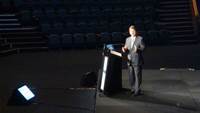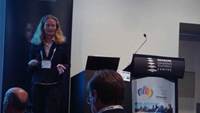The switch to the cloud was as "radical" as that which saw early electricity technologies grow in popularity before they were abandoned for the power grid, controversial US author Nicholas Carr told an audience in Brisbane today.
He compared the 1200 horsepower water wheel built by US iron magnate Henry Burden in 1851, abandoned 70 years later, to the shift to grid, utility or cloud computing.
Speaking at the World Computer Congress, Carr, who wrote The Big Switch, likened last century's move to the power grid to the cloud-computing debate.
Despite the hype and "fuzzy" definitions of the cloud, Carr said that a "radical switch" to utility computing was in the works.
"Until 1900, the assumption was you had to run power generation as an internal function," he told delegates.
"In short order, when the utility model arrived, people allowed their waterwheels, steam engines, internal generating plants to go by the wayside, and plugged into the grid.
"To make that mental shift must have taken an obvious leap of faith in management at the time," he said.
Carr highlighted a survey from July last year by security vendor F5 Networks that found 52 percent of 250 international enterprises it polled to be using a cloud service; only 1 percent rejecting the notion of the cloud.
But a Forrester survey of 679 enterprises in the same year found only 3 percent to be using the cloud while 41 percent were not interested.
He explained that the definition of cloud computing had become "fuzzier and fuzzier" as hype grew, and adoption of infrastructure as a service "hasn't really begun yet".
Organisations could deploy a "private cloud" to manage enterprise resources, lower costs and on demand, much like a power utility.
Hurdles such as capacity, security, reliability, connectivity, data portability and inertia were diminishing, Carr said.
The Google perspective
Cloud computing was named as one of four "converging trends" to shape technological innovation in a separate presentation by Google Australia engineering director Alan Noble.
Addressing delegates in yesterday's closing keynote session, Noble highlighted a "tectonic shift to cloud computing", consumerisation (where once expensive IT became commonplace and affordable), mobile growth and the pervasive use of social media.
Describing web search as the "canonical example of cloud computing", Noble said "the only real cloud is a public cloud".
He defined cloud computing as hosted applications and platforms that were built on a shared infrastructure and delivered in a browser.
"Cloud computing brings massive scale," Noble said. "It's through sharing that you're able to leverage scale and utilise the utility-on-demand aspects of the cloud."
And cloud enabled applications that were otherwise too expensive or difficult to use.
He highlighted maps, real-time translation and voice-to-text as examples of such applications.
IT managers today were more interested in speed and ease of integration than they were just a few years ago when cost and features were debated.
"Companies such as Google - online service providers - we are really only as good as the trust that our users maintain in us," he said, addressing a question on privacy issues with Google's Street View.
"If we lose our users' trust then we really have nothing. There's nothing stopping you from switching web search providers; you are literally one click away from competitors."
Both Carr and Noble noted the consumerisation of enterprise IT. Noble said Google built social networking (Buzz), office (Apps) and browser (Chrome) applications to address this trend.
Carr expected organisations to be more receptive as network speeds increased and companies such as Google, Microsoft and IBM built out a "cloud grid".
"Organisations now have to choose whether to be the disruptor or the disrupted," Carr said. "At the very least, it's more fun to be the disruptor."








.png&h=140&w=231&c=1&s=0)

_(20).jpg&h=140&w=231&c=1&s=0)





 iTnews Executive Retreat - Security Leaders Edition
iTnews Executive Retreat - Security Leaders Edition











_(1).jpg&h=140&w=231&c=1&s=0)



